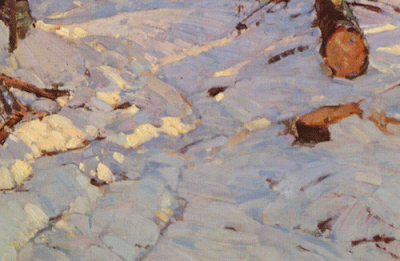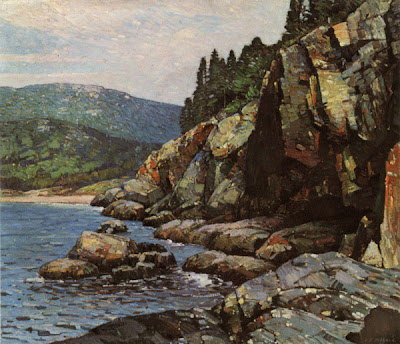
I have been writing the last few nights about brushwork. One of the differences between a blog and a book is that when writing a book you can assume that everybody as read chapter 42 before they read chapter 560. In the blog they pick up wherever they please and I am again wondering whether to repeat what I have said before on brush work, or assume you have seen it. What I think I will do is to post some excerpts from previous posts on brushwork so I know that new readers will have seen them. This may make for a choppy post but here they are.
-------------------------------------------------------------------------------------------------------------
I am going to list the things that must be considered every time your brush touches the canvas. They are legion. Every time you paint a "note" you need to understand the following things. I am proposing a sort of checklist. However it is long enough that it will take some time for you to be able to automatically apply each of these ideas. But if you start to look for several of them it will help your painting and gradually you can expand your checklist to include all of these. You must consider these qualities listed below in every brushstroke.
- Is this brushstroke in the right place?
- Is it in the light or is it in the shadow?
- Is it the right value?
- Is it the right color?
- Is it the the right chroma, that is, is it too saturated or is it too grave ( gray)?
- Is the temperature of the color correct, is it too warm or is it too cool?
- Be visible or invisible. If it is visible it will:
- Run with or along the form. Imagine a brushstroke running up the trunk of a tree.
- Run around or across (against) the form, like a ring going around or a plane laying horizontally across the surface of an object.
- It may obscure the form. Think of this as a basket weave pattern, or a flurry of small strokes. You might expect to see this in dense foliage for instance.
- It may be a pointille dot. That is a small spot of paint placed usually as an accent, nearly round or squarish in shape, but not greatly elongated.
- have the edge painted correctly, either hard or soft.
--------------------------------------------------------------------------------------------------------------
A brushstroke can run with, or along the form. Often this is used to show strength, as perhaps in a leg that is intended to look powerful or tensed.The brushstroke may obscure the form. Think of this as a basket weave pattern, or a flurry of small strokes. There are times when an artist wants to describe form and there are times to obscure it.
The brushstroke may be a pointille dot. That is a small spot of paint placed usually as an accent, nearly round or squarish in shape, but not greatly elongated. Usually a painting is not made out of these but they are a decorative accent within a painting.
DO EVERYTHING WITH THE LARGEST POSSIBLE BRUSH.
As many of you know I am strongly influenced by the historic Rockport school of painting. One of the things that characterizes that style is square touch. It is a kind of brushwork. Here is a bit of painting with a square touch by Aldro Hibbard, a master of the technique.
 If you look at the painting you can see it is made from square marks made by a flat brush. That gives the artist several advantages. The first is that it gives a structural look. It allows the creation of clear planar representation of the form and the different planes or facets of an object can be painted in different colors or temperatures.
If you look at the painting you can see it is made from square marks made by a flat brush. That gives the artist several advantages. The first is that it gives a structural look. It allows the creation of clear planar representation of the form and the different planes or facets of an object can be painted in different colors or temperatures.The second advantage of square touch is it gives a kind of pixilation. Rather than smoothing the painting out into a infinitely rendered appearance, the square brush mark is the unit of construction. If something is smaller than that mark it is effectively edited out, thus simplifying the representation. I think it is a powerful and interesting look in a painting and I generally have some degree of square touch in my work. Too much smoothing of the surfaces in a painting can give a slick or flaccid look. In a landscape square touch seems to me ideal for representing the texture and ruggosity of nature. I don't think it is so great for painting portraits of delicate little girls, but outside with rocks and snow and weeds it is great.




12 comments:
I am totally in agreement with the idea of using the biggest brush possible. It keeps you focused on the big powerful things that really count. And it totally rules out getting stuck in meaningless detail.
Thank you Stape! Love your teaching!!!
I find that many student artists begin a painting with a large brush all with good intentions but if they have the small brush with them they inevitably resort to the small brush (held like a pencil). So another piece of advice would be to leave your small brushes at home or in the car- somewhere so that they can't be mindlessly whipped out.
While there is no one way to do anything, it seems to me that this kind of laying on of the paint has to go over a really good foundation of some kind. Something like a really basic value study or wipe away that is dry, so that the under work will not muddy the lay on.
I so appreciate that you repeat lessons and info from the past. I love your reference to the ruggosity of nature!
Focus and awareness. Famillarity and ruggosity.
Stape, this is so helpful, Thanks!
Philip;
Big brushes,give power, small brushes are weak!
..........Stape
Sandra;
Thanks. I am used, therefore I am useful!
.................Stape
Marian;
That is a good suggestion. It is hard not to reach for that rigger until you make a habit out of using a big brush.
...........Stape
Willek;
Yes a good scaffolding under a painting is very useful.
..........Stape
Pam;
Thank you.
..........Stape
bill;
Thank you. I am trying.
...........Stape
Post a Comment